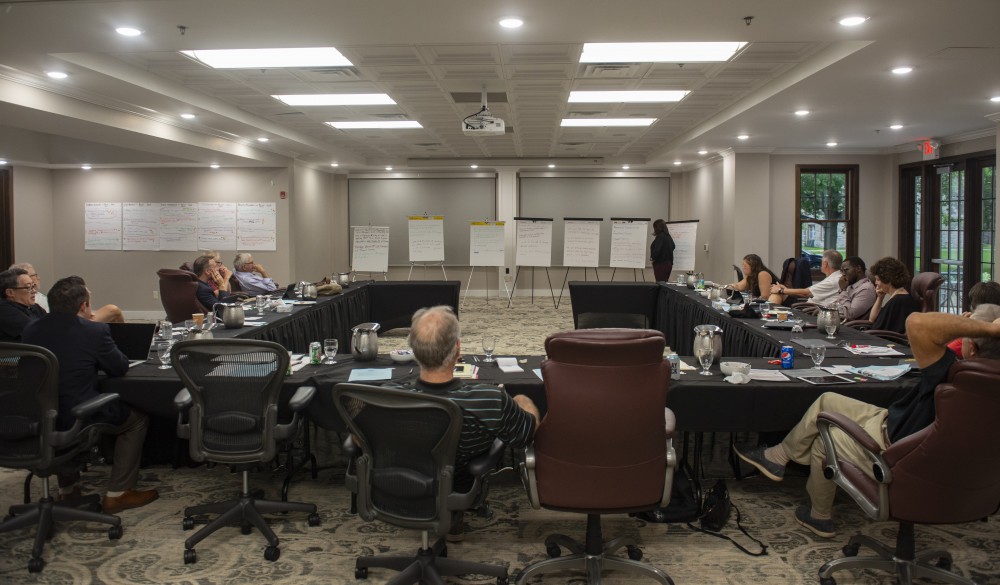As students flood back to campus, University of Minnesota regents are preparing to dive into Joan Gabel’s first semester as president by outlining several priorities for the year.
Baked into nearly all of the Board of Regents’ conversations this year will be developing the next systemwide strategic plan. Still, the priorities narrow in on more focused areas ranging from diversity and inclusion, the impact of the University’s outreach, tuition and enrollment strategies and the Medical School’s partnership with Fairview Health Services.
Board Chair Ken Powell noted these areas of strategic emphasis do not limit the board as it will work to address a wide variety of topics during the upcoming academic year, such as student mental health, an issue Gabel has embraced in her presidency.
“We want you to learn and achieve, but we want you to stay well,” Gabel told new students at last week’s convocation. “Every member of the faculty and staff are here for you, and you are not alone.”
As Gabel welcomed new Gophers, she emphasized the diversity of the incoming freshman class, saying they are the “most diverse class in a generation, in every way we define that word.”
While Powell said the University is making steady progress in terms of student diversity, the board looks to better understand how to achieve greater diversity across the system, not only among students but faculty and staff as well.
“Are we seeing that same kind of progress when it comes to grad students and faculty? And if that is not happening, we would like to start to understand why and what we can do to promote greater diversity across the faculty,” said Powell, who took over as board chair in July.
Powell, a former chief executive officer at General Mills, spoke of his own experience in private industry, saying more diversity in senior roles could be motivating to new employees. He said the same is true at the University, believing the more diversity among faculty and staff, the more students of diverse backgrounds will feel comfortable on campus.
Minnesota Student Association President Mina Kian said she is very excited to see diversity and inclusion as one of the board’s priorities, saying it’s an issue the board has not addressed enough in the past.
“I think that there is so much room for growth in the way that we choose to not only invite these folks to come into our community and serve in our institution, but find ways to maintain them,” Kian said.
Another mainstay of MSA’s focus is controlling costs for students and illustrating to the board the impact of tuition increases. This year, regents look to bring in external input to evaluate tuition and enrollment strategies and come up with a multi-year financial framework to balance the excellence of the University with affordability for students.
Regent Michael Hsu said these discussions are a primary interest for him, and he hopes to have a systemwide strategic plan before next year’s budget discussions ramp up in the spring. Hsu said he believes the University can admit more students and maximize tuition revenue without a hike for students.
“Everybody sitting in a seat is more money for us,” he said. “If we have empty seats let’s fill them up with Minnesota kids, and if we can’t fill them up with Minnesota kids, then fill them up with other kids.”
These conversations will certainly include one of the most frequent topics of the board: controlling administrative costs. Powell said using external resources that specialize in controlling costs and managing revenue can further inform the discussion around such costs as well as enrollment and tuition.
A priority Powell sees as a carryover from last year regards the University’s partnership with Fairview, expanding on the deal reached last fall which will bring the medical school $35 million in the first year.
The board wants to develop a plan for M Health Fairview based on quantifiable goals such as research dollars and national rankings. They also want to focus on the amount of research in certain areas like medical technology, an area Powell said is a “natural” given the robust, local medical device industry.
Regents seek to elevate the national reputation of the University to a top 10 research institution while promoting opportunities addressing specific challenges faced by the state. Powell said using the research and teaching capabilities of the University can be a large part of its outreach mission.
Powell cited several programs from the Minnesota Landscape Arboretum to 4-H programs across the state that serve Minnesotans, but admitted that some of them may be out of date and need to be refreshed. To properly assess these programs, regents need to have a robust measure and understanding of the current impact of outreach.
“Are there programs that are good programs that are outdated and need to be modernized to stay relevant?” Powell said. “It’s that kind of conversation and we really haven’t been able to do that.”








